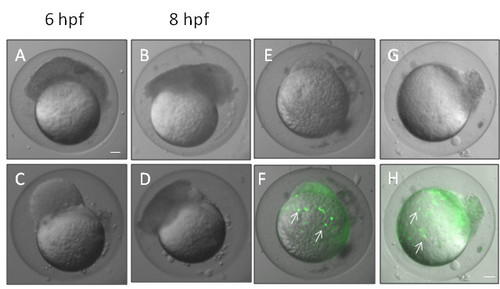- Title
-
Desmosomal cadherins in zebrafish epiboly and gastrulation
- Authors
- Goonesinghe, A., Luan, X.M., Hurlstone, A., and Garrod, D.
- Source
- Full text @ BMC Dev. Biol.
|
Desmosomal cadherins are expressed from early development onwards. Semi-quantitative RT-PCR analysis of zfDsc, zfDsga, zfDsgb and zfβ-actin expression through the first 96 hours of zf development. For further detail see text. |
|
Expression of zfDsc orthologue during zebrafish embryogenesis. Expression of zfDsc revealed by WISH (purple colour). Note the prominent staining in the EVL during gastrulation, and subsequently in the notochord, otic vesicle, pronephric duct, heart and epidermis. |
|
Knock-down of individual desmosomal cadherins causes developmental defects. The effects of morpholino knockdown of zfDsc and zfDsga as recorded at 24 hpf. As phenotypes for both morpholino knock-downs were very similar, representative images from their relative phenotypic classifications are shown in E-P. For comparison, WT animals are shown in A-D. Quantification of phenotypic distribution from morpholino knockdown of zfDsc and zfDsga are shown in Q and R, respectively. (N.B. Embryos that showed epiboly defects (see text and Figure 5) generally did not progress beyond 10 hpf and are therefore recorded as dead in this figure.) Quantification of standard control morpholino induced phenotypes and zfDsc/zfDsga knock-down embryos that have been partially rescued with corresponding Dsc1/Dsg2a mRNA are shown in S and T, respectively. Scale bars in A, E, I and M = 40 μm; other scale bars = 20 μm. PHENOTYPE:
|
|
Knockdown of desmosomal cadherins causes epiboly defects. A and C show morphants at 6 hpf whose blastomeres became detached and failed to migrate towards the vegetal pole. The blastomeres of these embryos still continued to divide and seemed to undergo movements resembling gastrulation movements (B, D). These images are representative of similar phenotypes obtain by knockdown of both zfDsc1 and zfDsg2. E, F and G, H show embryos that were injected with Sytox to stain the nuclei of the YSL (white arrows in F, H). The DIC images (E, G) show that the blastomeres had become detached while the merged DIC and fluorescence images (F, H) show that the YSL had continued epiboly movement toward the vegetal pole. (Embryos such as those shown in this figure did not survive beyond about 10 hpf and are recorded as dead in Figure 3.) E, F were obtained by knockdown of Dsc1 and G, H by knockdown of Dsg2. Scale bars = 100 μm. PHENOTYPE:
|
|
Knockdown of desmosomal cadherins affects convergent-extension movements. Representative DIC images of wild type and morphant embryos at 9-11 somites to illustrate convergent-extension defects produced by knocking down zfDsc1 and zfDsg2. A-C Dorsal views showing abnormal somite structure. D-F Lateral views showing shortening of embryonic axis (head and tail indicated by upper and lower arrowhweads, respectively). G-L Higher magnification pictures showing medio-lateral widening of somites (double headed arrows in G-I), kinking of notochord (arrows in H, K) and loss of chevron structure of somites (J-L). Scale bars = 100 μm (A-F) and 50 μm (G-L). PHENOTYPE:
|
|
Knockdown of desmosomal cadherins affects gastrulation movements. In situ hybridisation images for gata1 at 30% epiboly (A) and myod, krox20 (B) at tailbud stage for both zfDsc1 and zfDsg2a morphant embryos. WT embryos are shown for comparison. A.i. and A.ii. show the lateral (Lat) and animal pole (AP) views, respectively. Circles indicate the expanded expression of gata1 in the germ ring margin of the morphants. B.i. and B.ii. show the dorsal (Dor) and lateral (Lat) views, respectively. Double headed arrows in B.i. indicate medio-lateral expansion of the distance between krox20 markers (pointed arrows) and myod marker (blunted arrows). Short arrows in B.ii show reduced rostro-caudal extension as indicated by the myod marker. EXPRESSION / LABELING:
|
|
Knockdown of desmosomal cadherins affects desmosome structure. A. Apical junctional complex between cells of the EL of wild type embryo at 24 hpf showing the tight junction/adherens junction region (tj, aj) and the extensive array of desmosomes (d). At epiboly (B) the tight junction/adherens junction was present but no desmosomes were found. By the shield stages (C) fully formed desmosomes (arrow) were present forming the lowest component of the junctional complex in wild type embryos. D. A single fully formed desmosome (arrow) found in a morpholino injected embryo that reached the shield stage. At the 8 somite stage (E) desmosomes (arrow) were present at the lower aspect of the junctional complex in wild type embryos. F. A representative sample of abnormal desmosomes (arrows) form morpholino injected embryos that reached the 8 somite stage. Scale bars: A = 1 μm; B-F = 0.5 μm. PHENOTYPE:
|







